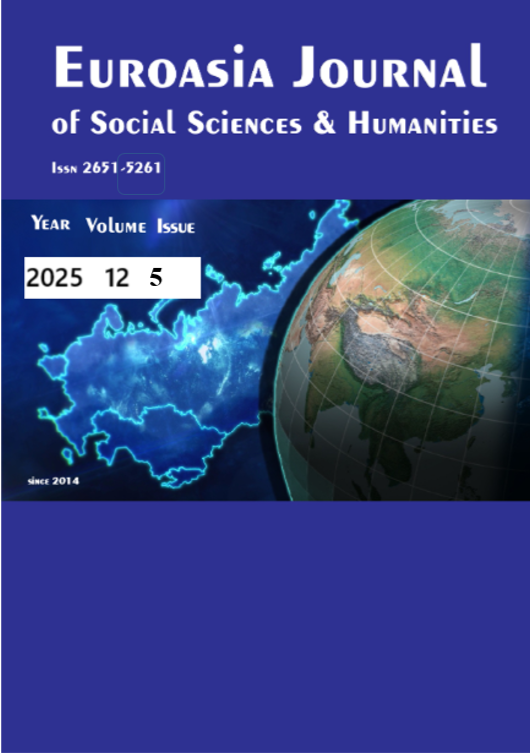The Language of the Story “Tenezzüh” Written in Ottoman Turkish
DOI:
https://doi.org/10.5281/zenodo.17392594Keywords:
Ottoman Turkish, Ömer Seyfettin, Vocabulary, Syntax, Language ChangeAbstract
Ömer Seyfettin’s short story “Tenezzüh,” published in the newspaper Sabah in 1902, is among the author’s earliest known works and represents the initial phase in his literary trajectory from Ottoman Turkish to a simplified Turkish. This text strongly reflects the characteristic elements of the late Ottoman linguistic atmosphere: the predominance of Arabic- and Persian-origin vocabulary, syntactic patterns based on compounds and constructions, rhetorical features of the literary style, and the distance between written and spoken language. In the late Ottoman Empire, Ottoman Turkish, the dominant language in official and cultural spheres, was a multi-layered written language built upon a Turkish core, integrated with Arabic-Persian vocabulary and grammatical patterns. While this language set the norms of high literature and the press, it also became the focal point of debates on simplification and the quest for a national language in the course of modernization. The vocabulary and syntax of “Tenezzüh,” written in Ottoman Turkish during the transitional period, will be described through the distribution of Arabic and Persian elements in the text; the relationship between this distribution and stylistic as well as narrative functions will be revealed. The analysis will first produce a lexical inventory based on an etymological classification within the text; it will distinguish Arabic (e.g., tahattur, muâşaka, sekerât), Persian (e.g., pîş-i hayâl, hâl, formulaic elements such as maşaallâh), and Turkish items and determine their proportions. Then, syntactic features such as the prevalence of izafet, chains of compounds, compound modifiers, and long sentence structures will be examined; their role in the narrative’s temporal flow, the rhythm of descriptive passages, and the production of affect will be evaluated. Thus, “Tenezzüh” will be positioned as an intermediary example that both makes visible the practices of the literary written language in the final phase of linguistic history and helps to make sense of Ömer Seyfettin’s subsequent tendencies toward simplification. The findings aim to discuss the composite nature of the late Ottoman written language and the axes of continuity and rupture in the transition to modern Turkish through the short story “Tenezzüh.”
Downloads
References
Aksan, D. (2006). Türkçenin Sözvarlığı. Ankara: Engin Yayınevi.
Baran, B. (2018). Osmanlı Türkçesi Öğretiminde Arapça, Farsça ve Eski Anadolu Türkçesinin Yeri. Uluslararası Türkçe Edebiyat Kültür Eğitim (TEKE) Dergisi, 7(4), 2131-2142.
Coşkun, O. (2020). Osmanlı Son Dönem Çeviri Yöntemleri Üzerine Bir İnceleme. Dil ve Edebiyat Araştırmaları(21), 223-263. https://doi.org/10.30767/diledeara.686650
Çeri, B.(1998). XIX. Yüzyıldan Osmanlıca Bir Sözlük Lehçe-i Osmânî. Kebikeç. sayı 6, 169-174.
Değirmençay, V. - Çağlayan, P. S. (2017). Fahreddîn-i Irâki Divanı’nda Tamlama Çeşitleri. Divan Edebiyatı Araştırmaları Dergisi 19/19 19-36
Dırahşan, C. ve Olgun, İ. (1984). Farsça-Türkçe Sözlük, Ankara: Murat Kitabevi Yayınları.
Ercilasun, A. B. (2004). Başlangıçtan yirminci yüzyıla Türk dili tarihi. Ankara: Akçağ Yayınları.
Ergüzel, M. M. (2015). Milli eğitimde Osmanlı Türkçesinin seçmeli ders olarak öğretilmesi üzerine. Turkish Studies, 10(8), 35-41.
Güneş, K. (2014). Arapça-Türkçe Sözlük. İstanbul: Mektep Yayınları.
Kanar, M. (2011). Osmanlı Türkçesi Sözlüğü. Ankara: Say Yayınları.
Kızıler, R. (2020). Ömer Seyfettin Toplu Hikâyeler. İstanbul: Türkiye İş Bankası Kültür Yayınları.
Özbek, E. (2015). Türkiye’de "Söz Varlığı" Çalışmaları ve Bunlar Üzerine Genel Bir Değerlendirme. Akademik Kaynak, 3(5), 23-38.
Özkan, Ü. B. (2020). Ömer Seyfettin’in Hikâye Dünyasında İktisadi Hayat. Türklük Bilimi Araştırmaları, sy. 48, 2020, ss. 167-88.
Polat, N. H. (2020). Ömer Seyfettin: Bütün Hikâyeleri. İstanbul: Yapı Kredi Yayınları.
Yavuzarslan, P. (2004). Türk Sözlükçülük Geleneği Açısından Osmanlı Dönemi Sözlükleri Ve Şemseddin Sâmî’nin Kâmûs-I Türkî’si. Ankara Üniversitesi Dil ve Tarih-Coğrafya Fakültesi Dergisi, 44(2), 185-202.
Downloads
Published
How to Cite
Issue
Section
License
Copyright (c) 2025 EUROASIA JOURNAL OF SOCIAL SCIENCES & HUMANITIES

This work is licensed under a Creative Commons Attribution-NonCommercial 4.0 International License.

